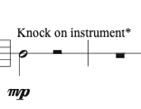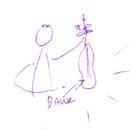SPOR
for fiolin solo og strykeorkester
Agnes Ida Pettersen
SPOR
for fiolin solo og strykeorkester
Score
Bestilt av De Unges Orkesterforbund i anledning Orkesteråret 2024
Copyright © 2025 by Norsk Musikkforlag www.notebutikken.no
Materialet er vernet etter åndsverkloven. Uten uttrykkelig samtykke er eksemplarfremstilling, som utskrift og annen kopiering, bare tillatt når det er hjemlet i lov (kopiering til privat bruk, sitat o.l.) eller avtale med Kopinor (www.kopinor.no).
Utnyttelse i strid med lov eller avtale kan medføre erstatningsog straffeansvar.
This material is protected by copyright law. Without explicit authorisation, reproduction is only allowed in so far as it is permitted by law or by agreement with a collecting society.
ISMN 979-0-065-18056-4
Grafisk produksjon/trykk: Norsk Musikkforlag Grafisk design omslag: Blå Design
Utgiver: Norsk Musikkforlag www.notebutikken.no

Takk til Kulturrådet, Musikkforleggerne og Landsrådet for Norges barne- og ungdomsorganisasjoner for støtte vi fikk til prosjektet
SPOR
for fiolin solo og strykeorkester
Komponert til prosjektet LYDFRYD, og ungdomsorkestrene Vestre Aker Strykeorkester og Østfold Ungdomsorkester. av Agnes Ida Pettersen
Durata 5,5 minutt
Bestilt av De Unges Orkesterforbund
Støttet av Kulturrådet
Komponert vår 2024
Materiale:
Partitur
Stemmer: Solo Fiolin, Fiolin 1, Fiolin 2, Bratsj, Cello, Kontrabass
Pianouttog.
SPOR
for violin solo og string orchestra
Composed for youth orchestras by Agnes Ida Pettersen
Durata 5,5 minut
Commissioned by De Unges Orkesterforbund
Supported by Arts and Culture Norway Composed spring 2024
Materials:
Score
Parts: Solo Violin, Violin 1, Violin 2, Viola, Cello, Double Bass Piano reduction.
FORORD:
Divisi
Dirigenten kan fordele divisi til det beste for sine musikere.
Symboler/teknikker


trekant notehode - så høyt fingergrep som mulig. Kun brukt i forbindelse med støylyd.
Firkantede rotehoder, viser til støy/luftstøy. Demp strengen med to fingre med flageolett-trykk. Få frem en susete støylyd. Utføres på angitt streng. Brukes med og uten glissando (soft noise gliss - hørbar bevegelse)
Bank på instrumentet

Høyt buepress, langsom bue.
Alltid notert på en linje.
Hold fiolinen/bratsjen ved stemmeskruene slik at den henger i lufta. Bank forsiktig på instrumentet med høyre hånd slik at et mykt anslag setter igang strengene.

Buepress med rotasjon (kontrabass)




Svært langsom bue. Lag en knudrete, men svak lyd, ved å legge på litt ekstra press på buen. Målet er en stabil støyklang og så godt som ingen lyd av den vanlige tonen.
Press buen, al tallone, bestemt mot strengen. Demp strengen og nabostrengen(e). Roter buen rundt kontaktpunktet. Også mulig å bruke to hender for økt press. Det skal klinge kornete/granulert, litt som en dør som knirker. Forsøk å hold indikert varighet ved å utføre rotasjonen langsomt og stabilt.

Very high natural harmonic/noise - med varighgetsstrek.


Bruk flageolett grep, veldig høyt på strengen, gjerne start helt over gripebrettet. Slipp lyden ut, det kan bli en luftig støylyd eller en forsiktig harmonic - helst litt av hvert. Flytt litt på grep-fingeren i ditt eget tempo slik at lyden endrer seg langsomt og det oppstår en sammensatt og kontinuerlig varierende klang av hele gruppen. Utfør aktiviteten til pilen slutter.
harmonic/noise glissando



Samme teknikk, men med en langsom glissando. Start høyt oppe og beveg deg nedover på strengen i et strekk. Beregn tiden så glissandoen varer hele linjen ut. Ikke veldig sterkt, men hørbart.
PREFACE
Divisi
Divisi-parts may be distributed to the best of the orchestra's capabilities.
Symbols/techniques


triangular notehead - as high as possible. Used only for noise.
Square noteheads indicate noise - the quiet and airy type. Use two fingers with harmonic pressure to dampen the string. Execute on the given string and pitch indication. Both static and glissandos shall be audible.
Knock on instrument is always notated on a one-line staff.

High bow pressure, slow bow.
Hold the violin/viola by the tuning screws so that it hangs in the air. Gently tap the instrument with your right hand. The soft impact allows the strings to vibrate quietly.

Rotating Bow Pressure:


Create a gnarled but mild sound by applying a little extra pressure to the very slow bow. The aim is a stable noise timbre and virtually no sound of the regular tone.
Press the bow, al tallone, firmly against the string. Dampen the string and the neighbouring string(s). Rotate the bow around the contact point. It is also possible to use two hands for increased pressure. It should sound grainy/granular, a bit like a creaking door. Try to keep the indicated duration by performing the rotation slowly and steadily.

Very high natural harmonic/noise - with duration indication.


Use harmonic grip, very high on the string, preferably starting above the fingerboard. It can be noise/air or a gentle harmonicpreferably a bit of everything. Move the finger slightly at your own pace so that the sound changes slowly and a complex and continuously varying sound is created by the whole group. Perform until the arrow ends.
harmonic/noise glissando

The same technique as above, but with a slow glissando. Start high up and move down the string in one stretch. Calculate the time so that the glissando lasts the entire stretch.
slow bow, higher pressure, soft noise in the background. slow bow, higher pressure, soft noise in the background.
DEMO
DEMO
DEMO

